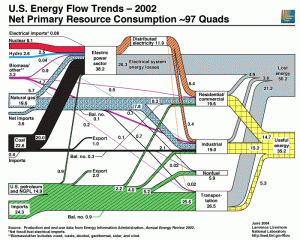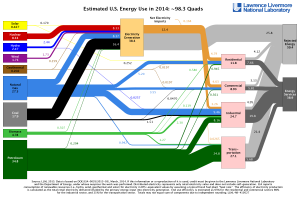
The Lawrence Livermore National Laboratory releases the Energy Flow Chart for the U.S. every year. The latest Energy Flow Chart is here.
As we have highlighted previously, the U.S. loses more than 67.8% of the electricity that is generated in our Grid. These losses are categorized as “Rejected Energy.” The U.S. Energy Information Administration estimates that electricity transmission and distribution losses are 6% annually
US Energy Information Administration FAQ “How much electricity is lost in transmission and distribution in the United States?”
Accessed December 21, 2015 Last Updated: July 10, 2015 https://www.eia.gov/tools/faqs/faq.cfm?id=105&t=3
which leaves nearly 62% of the losses split between Generation and Consumption with an unknown percentage occurring on either end.

“Electrical System Energy Losses” were tracked until 2002, when they were merged into the “Rejected Energy” category which includes both waste and losses. There is a distinction between these two. We are specifically referring to losses and waste in the Grid so the term “electricity” is more appropriate than energy. The Rejected category encompasses both lost and wasted electricity.
The difference:
- Loss is non-recoverable, I2R losses that would occur in a theoretically ideal electrical network.
- Waste is recoverable, a result of unsynchronized power and non intelligent distribution of electricity.
The next logical question is, “How much Waste is recoverable?”
It is known that electricity needs “correction” or synchronization to operate efficiently. There are various electrical distortions that naturally occur in electricity that force the Current and Voltage waveforms from their naturally sinusoidal shape (i.e. power factor, harmonics, voltage sags or swells, etc.) These distortions can be temporarily mitigated through various means of manipulation that increases the efficiency of the electricity used. Over time, newer methods and products have been introduced to the market that incrementally increase electrical efficiency.
This is not an exhaustive list of problems or solutions, but a general understanding of the types of products and methodologies that currently exist.
| Electrical Distortions | Converting Electricity | Unbalanced Phases | External Grid |
|
|
|
|
The Power Quality market, which is made up by these products, is enormous and all compete to recover Waste in our Grid. These companies make billions of dollars so the opportunity is huge, but how huge? How big is the “Wasted Electricity” market? The answer is somewhat frightening because nobody knows. We lack adequate Measurement and Verification methods to tell us precisely what is occurring in the Grid at any given moment.
With 3DFS Technology, we not only solve the Measurement and Verification problem, but can also solve the Wasted Electricity problem with Subcycle Correction.
In the last 7-8 years, through a detailed analysis of Waste in the grid using data we have collected, we estimate that more than 50% of the “Rejected Energy” category as depicted by the LLNL is recoverable. This means that a fully optimized Grid with zero waste would nearly double the capacity of available electricity every year.
Electrical Waste in live environments is typically exhibited as heat or vibration in the infrastructure, components, and wires, anywhere electricity is used. By eliminating waste in the electrical network, heat and vibrations related to waste will be eliminated leaving only non-recoverable losses in the Grid. Imagine the possibilities. Our Grid can be fully automated and use only the electricity required with full efficiency in the very near future.
To learn more contact 3DFS at power@3dfs.com.



